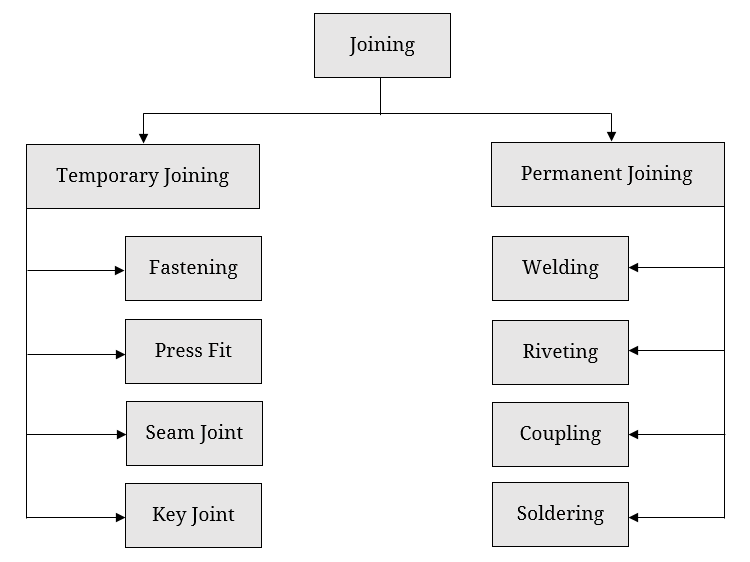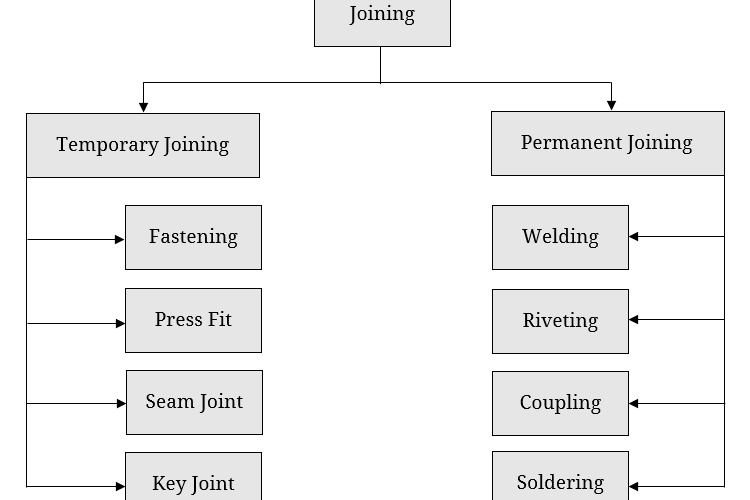Manufacturing, a crucial step in production system, converts raw materials and scraps into useful products by adding sufficient value. However, all physical products cannot be produced in same way. Accordingly there exist several manufacturing processes in order to fabricate different objects made of different materials and having varying features. Such manufacturing processes include casting, joining, forming or metal working, machining or metal cutting, heat treatment, coating and coloring, rapid prototyping and powder metallurgy. Each of them has different capability in terms of suitable work materials, product shape and size, feature type, component size, dimensional accuracy, tolerance level, etc.
What is joining?
Joining is one of the manufacturing processes that is used to assemble two or more solid components or structures together. It can be employed to permanently or temporarily join any type of engineering materials such as metals, ceramics, plastics and composites. In order to cater the need to join wide variety of materials in several ways, there exist various joining processes, which can be broadly classified into two groups—temporary joining processes and permanent joining processes.
Temporary joining—As the name suggests, a temporary joint is not fixed. That means it allows easy and quick dismantling of jointed structures without breaking them. This is very useful for inspection, maintenance and repairing purposes. However, such joint may not necessarily be strong and leak-proof. Typical joining processes that allow temporary joints include fastening, cotter joint, knuckle joint, key joint, press fit, seam joint, etc.
Permanent joining—A permanent joint is meant to stay fixed for long duration. It does not allow disassembly of jointed structures without breaking them. It possesses challenge during inspection, maintenance and repairing purposes as sometimes component or structure parts are required to damage. However, it offers a sound, reliable and leak-proof joint with high load carrying capacity. Typical permanent joining processes include welding, riveting, soldering, brazing, coupling, adhesive joining, etc.

What is welding?
As mentioned earlier, welding is one type of permanent joining process like riveting and coupling. It is one age old joining process that can efficiently and economically assemble two or more structural members permanently. By definition, welding is one of the joining processes by which two or more solid components can be joined permanently by coalescence formation with or without the application of external pressure, heat and filler metal.
As usual, there exist large number of welding processes for efficiently and reliably joining wide variety of materials in innumerable ways. Examples include arc welding processes (MMAW, GMAW, TIG, SAW, FCAW, ESW, etc.), gas welding processes (OAW, OHW, AAW, PGW, etc.), resistance welding processes (RSW, RSEW, PW, PEW, FW, etc.), solid state welding processes (DFW, PW, ROW, CW, FRW, FOW, etc.), and intense energy beam welding processes (PAW, LBM and EBW). Each of them offer certain advantages over others.
How welding differs from joining?
Welding is one type of joining process; others being riveting, soldering, adhesive, brazing, coupling, fastening, press fit, etc. It is worth mentioning that with the advancement of welding technique throughout last few decades, now-a-days welding mostly superseded other permanent processes including riveting. In industrial scale assembly purposes, fastening and welding are overwhelmingly employed. Therefore, joining is a generic term that indicates assembly of solid components; while, welding is one particular method of joining that can assemble two or more parts temporarily. Mathematically, it can be said that welding is one subset of joining set.


